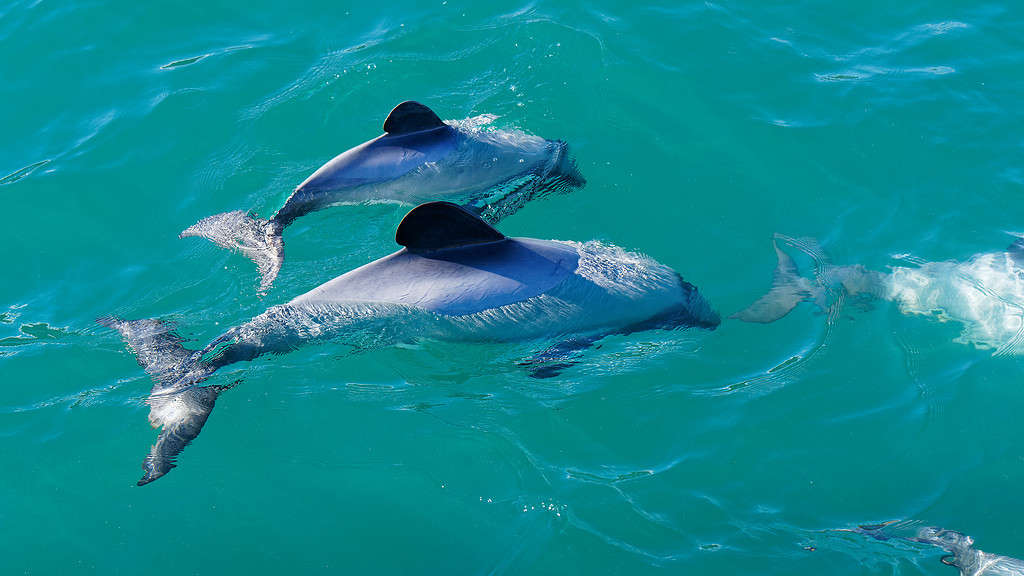
Dolphins communicate with each other, and potentially with people, but what are they saying?
©beaverboy56/Shutterstock.com
By now, scientists know that dolphins communicate with each other. They are a highly social species that have to stay in touch with one another to plan and coordinate. However, the details of how they communicate, what they’re saying, and how sounds and actions work together are still a mystery.
Communication vs. Language
Every animal and plant communicate in some form. Communication is simply the process of sharing information. Flowers have certain colors that communicate with insects that they have pollen. Deer will grow bigger antlers to display that they are older or healthier. Both of these are forms of communication, as simple as they are. However, even what appears to be more complex, such as sounds and postures, are just forms of communication, and not a language.
Language, on the other hand, is much more complicated. It allows for much more complex and detailed information to pass between speakers. Language involves a lot more than just sounds. Language is a system that combines small words or phonetics into sentences using a base set of rules. Writing, sounds, or gestures all provide ways to communicate via language. It’s currently thought that only people can develop and learn a language to share such in-depth information.
Think about body language, for example. You can show that you’re scared, uncomfortable, or happy without having to say a word. But you couldn’t say something like, “I just saw a fox on my way home from work”, with body language alone. Despite the name, it’s just a form of communication. You need complex wording, a language, to get the point across.
Some scientists are trying to determine if that’s true, starting with dolphins. It’s thought that dolphins are intelligent enough to have a proper language, instead of just communicating. Unfortunately, it’s not easy for scientists to tell the difference, and so they are still unsure about dolphin communication. Some scientists are starting to find signs of language, however.
Unfortunately, if dolphins don’t have a language, this means that many people’s dreams of one day talking to these majestic creatures are nothing more than just a dream.
The Different Ways Dolphins Communicate With Each Other

Dolphins communicate in touch, movement, sounds, and perhaps even echolocation.
©Gary Webber/iStock via Getty Images
Dolphins have many ways of communicating information, including various sounds and movements. It’s thought that echolocation also plays a part, but it’s not quite clear if this is the case or its role in dolphin communication.
Thanks to programs like the Dolphin Communication Project, there are a lot of sounds and forms of communication from dolphins recorded and studied.
Sound
There are two main sounds that dolphins make. These are whistles and clicks. Clicks are more used as a part of echolocation, while whistles seem to be more for communication. They also occasionally squeak or squeal, but these sounds aren’t quite as common.
Based on the information found so far, it seems that there are a lot of factors involved with making these sounds and getting the right message across. Not only do you have to make the right whistle or click, but the length and the pitch are also thought to be important.
When dolphins communicate, they take the time to listen to one another. There is little interruption. This hints at the fact that actual information is being shared, instead of just vague communication. Additionally, there are times when there are a lot of different vocalizations at the same time, similar to how people in a room are all talking at once, but each one is speaking to individual people or groups.
Challenges in Learning the Language
Unfortunately for us, and perhaps dolphins, humans aren’t any closer to understanding what they’re saying. There are some theories. It’s thought that they talk about a lot of information, similar to people. They, of course, mention things like watching out for predators and food sources nearby. However, some researchers suggest they talk about things like emotions and age with one another as well.
One of the biggest challenges of learning the language is that dolphins repeat certain sounds and movements in various situations with different meanings. It’s similar to the human language. Think about sarcasm, or when someone grabs your hand. They may grab your hand for a handshake, to take you with them, to force you to do something, or to flirt. Sarcasm is when you say something, but don’t mean it.
While most people can figure out the differences between these different actions and movements, it does make it harder to understand what exactly dolphins are trying to say when they repeat the same action or sound in different situations.
There’s also the fact that a lot of cues for language don’t come from what you say. Nonverbal cues are very important in determining the meaning behind words, and scientists currently don’t know enough about dolphins and their body language to translate it.
Changing Languages
There’s also the chance that communication between dolphins could be changing faster than scientists can learn it. In 2010, studies found that many dolphins stranded on the beach have hearing loss of some form, most of it significant.
By the time scientists figure out what dolphins are saying, they may be already changing to less vocal communication to make up for this hearing loss.
Signature Whistle
One interesting bit of information scientists and researchers have found from all their studies of dolphins is that each one has a unique signature. Every dolphin has a special whistle, dubbed a “signature whistle” by researchers. This is a sound that dolphins use to identify themselves and each other.
These whistles are rather short, lasting less than a second. Mother dolphins repeat their signature whistle and other sounds to their calf several times over the next few days. This potentially helps the young dolphin learn the right ways to communicate, and also be able to easily identify their parents.
These signature whistles help dolphins to keep in touch and make sure the whole group is present. Like how we use names, it may also allow dolphins to connect with one specific dolphin as well. However, this is all just speculation.
Movement
Movement isn’t as commonly used. While dolphins can see quite well in the water, it doesn’t work for long distances, and muddy or silty areas may limit visibility enough that it isn’t practical to rely on movement.
However, there may be times that dolphins use communication via movements, such as in intimate cases or when the dolphins are all close together.
Some movements you can see dolphins use include arching their back, showing the white of their eyes, wagging their heads, playing dead, and jerking their head sharply to the side.
Unfortunately, it’s unclear what most of these mean. The sharp jerk is likely an aggressive movement, while most of the others are signs of submission or friendliness, but the exact message isn’t yet known.
It’s hard sometimes with movements to decide if they are a form of communication or done to observe something. For example, there is something dolphins do called “sky hopping”. This is when they pop their heads out of the water, look around for the moment, and then go back under. They will repeat this a few times, and several dolphins may join in.
It looks playful and fun, to the point that it may be a game, but it’s also suggested that this is just a technique to keep an eye out for predators, like meerkats popping their heads up over their burrows.
Touch

Young calves and mothers often touch by brushing against each other as they swim.
©vkilikov/Shutterstock.com
There aren’t many studies yet in this area, but scientists who study dolphins have started to suggest that dolphins communicate with each other sometimes with touch. It seems touch occurs most often when dolphins are being aggressive, or between calves and their mother.
Calves will brush up against their mom as they swim alongside each other. Specifically, they’ll brush their fins against their parent’s side.
Thank you for reading! Have some feedback for us? Contact the AZ Animals editorial team.








